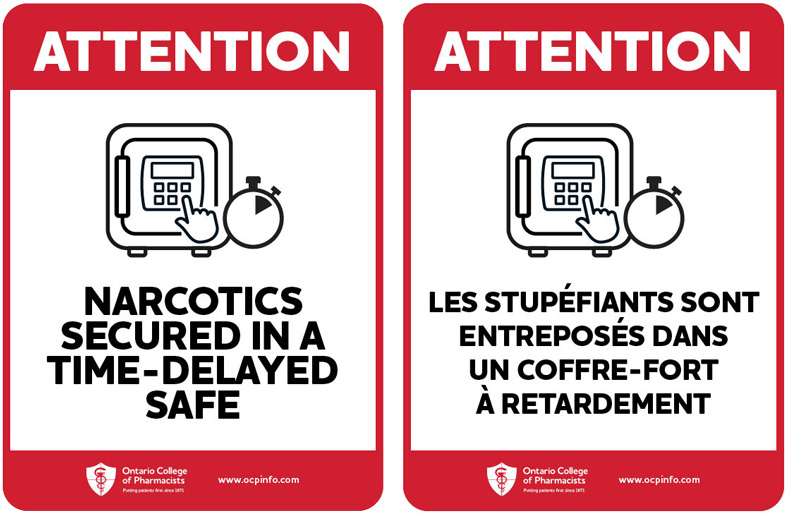Time-Delayed Safes Policy
Scope Statement
This policy applies to all accredited community pharmacies and remote dispensing locations with a dispensary. It does not apply to accredited hospital pharmacies or remote dispensing locations with an automated pharmacy system.
Purpose
This policy articulates the College’s expectations of the Designated Manager (DM) with respect to meeting the Standards of Accreditation and Standards of Operation for the storage of narcotics. It should be read and applied in conjunction with the above standards and the Designated Manager policies.
The Standards of Accreditation require every pharmacy to have the necessary equipment to ensure the safe and appropriate storage of drugs. The Standards of Operation dictate that controlled substances must be stored and managed according to national guidelines and provincial requirements.
Definitions
Designated Manager (DM): The Part A pharmacist designated by the owner(s) and reported to the College as responsible for managing the pharmacy. The DM carries the same liability for the operation of the pharmacy as the owner(s). (DPRA, Standard of Operation)
Narcotic: Any product or preparation which contains a drug named in the Schedule to the federal Narcotic Control Regulations. (NCR)
Remote Dispensing Location: A place where drugs are dispensed or sold by retail to the public under the supervision of a pharmacist who is not physically present. (O. Reg. 264/16)
Time-delayed safe: A safe that is constructed of solid metal and contains an integrated electronic locking mechanism with a time-delayed release.
Policy
Storage of Narcotics
All narcotics must be secured in a time-delayed safe located inside the dispensary. This includes unusable inventory awaiting local destruction or return to a licensed dealer.
- The safe must be secured in place, preferably to the floor, or of a size and weight that it cannot easily be removed.
- Exclusions:
- Exempted (“Low-Dose”) Codeine Preparations that may be sold without a prescription.
- Prepared prescriptions awaiting pick up.
- Post-consumer waste in the Ontario Medication Return Program.
The time-delayed release must be set to a minimum of five minutes.
- Longer times may be warranted depending on the location of the pharmacy and law enforcement response times.
The use of override codes, keys, or other methods to bypass the time-delay are strictly prohibited.
- Access to safe codes should be restricted to as few employees as possible.
The door of the time-delayed safe must always remain closed and locked, opened only to:
- Retrieve stock to fill a prescription or perform a physical count.
- Return stock after filling a prescription or performing a physical count.
- Put away stock immediately upon receipt of an order from a wholesaler.
Temperature-sensitive narcotics must be stored in a locked refrigerator or in a refrigerator inside a locked room.
Signage
Prominent signage provides a consistent, province-wide deterrent message that the additional security measure of a time-delayed safe is in place. The following OCP-approved signs are required to be clearly displayed where they are readily visible to the public:

Community Pharmacy:
- At each public entrance, the College’s 11” x 17” ‘Narcotics Secured in a Time-Delayed Safe’ sign.
- At the area(s) where a patient should approach the dispensary, the College’s 8.5” x 11” or 11” x 17” ‘Narcotics Secured in a Time-Delayed Safe’ sign.
- Printing and posting guidelines
Remote Dispensing Location with a dispensary:
- At each public entrance, the College’s 11” x 17” ‘No Narcotics on Site’ sign
- At the area(s) where a patient should approach the dispensary, the College’s 8.5” x 11” or 11” x 17” ‘No Narcotics on Site’ sign.
Signs must be printed in colour and securely fastened in place. Damaged, faded, worn or illegible signs must be replaced promptly.
Exceptional situations
Community pharmacies that do not have a safe which conforms to the specifications above must have a secure room or vault with walls and a door meeting Health Canada Directive on Physical Security Requirements security level – 3 or higher. Entrance doors to the pharmacy must remain locked at all times. There must be at least one door with a time-delayed lock, or at least two secured doors in sequence which take at least 5 minutes to bypass, between the exterior entrance(s) to the building and the narcotic storage area.
Community pharmacies with a Dealer’s License issued by Health Canada[1] must have a vault meeting Health Canada Directive on Physical Security Requirements security level – 3 or higher. These pharmacies may post the 11” x17” signage so it is visible immediately after entering the accredited area.
There are no exceptions for community pharmacies based on their business model or location (e.g., not open to the public, situated in non-residential areas, not on the ground floor of a building, “mail-order” or delivery only, do not have or intend to have narcotics inventory).
Personnel Training
The DM is responsible for establishing written standard operating procedures and for the training and supervision of pharmacy personnel involved in handling narcotics.
Pharmacy personnel, and staff who work in a clinic or other business with a pharmacy on the premises, should receive training on the standards operating procedures, covering topics such as:
- Operation of the time-delayed safe
- Expectations for proper use and signage outlined in this policy
- What to do in the event of an armed robbery
- Reporting of suspicious activity
- Keeping sensitive information about the pharmacy confidential
Legislative References
Additional References
- Designated Manager – Medication Procurement and Inventory Management
- Designated Manager – Professional Supervision of Pharmacy Personnel
- Designated Manager – Required Signage in a Community Pharmacy Policy
- Health Canada – Controlled Substances Guidance for Community Pharmacists: Security, Inventory Reconciliation and Record-Keeping (Jan 2023)
Implementation
Published: March 25, 2024
Version #: 1.00
College Contact: Pharmacy Practice
Revision History
| VERSION # | DATE | ACTION |
|---|---|---|
| 1.00 | March 25 2024 | New policy published |
- Health Canada’s Office of Controlled Substances establishes national guidelines and oversees compliance and enforcement activities related to narcotics under federal legislation. ↑
